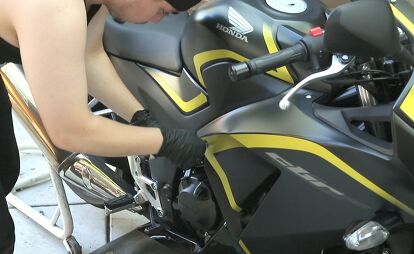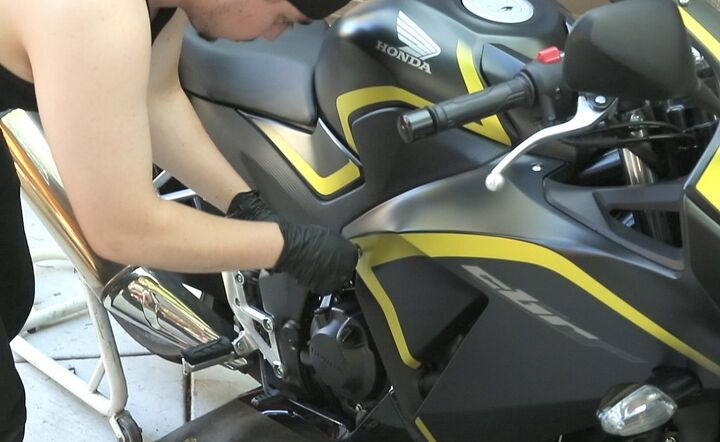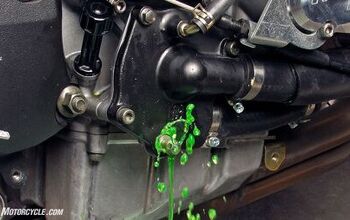MO Wrenching: How to Change Your Oil + Video

Your motorcycles heart needs a periodic transfusion
Changing your motorcycle’s oil is one of the most important – if not the most important – maintenance tasks you can perform for its engine. All those expensive moving parts within your engine won’t last very long without a coating of quality lubricant preventing metal-on-metal violence. If you’re new to wrenching, an oil change is the perfect confidence builder. It’s almost impossible to screw up and requires very few tools: sockets or allen sockets to remove bodywork, a wrench to remove the drain plug (ultimately, you’ll really want to use a socket and a torque wrench to get it tightened to factory specs on reassembly), an oil catch pan, and rubber gloves. Don’t worry about voiding a new bike’s warranty. Just save your receipts and keep a record of the date and mileage of each change.
MOto Mentoring: You’ve got your first bike. Now, what do you do? + Video
All you’ll need to buy is a new filter, drain plug crush washer, and replacement oil. Here is where newbies usually ask a few pertinent questions: How often should oil be changed? It’s best to check your bike’s manual for the recommendation of those who designed and built it. Do I need to use motorcycle specific oil? Again, do what the manufacturer recommends. Get motorcycle-specific oil.
Now, with the internet being what it is, someone will pipe up saying that they’ve successfully used Uncle Bobbie’s Engine Lube and Hair Tonic (made with genu-wine chicken fat) for over 20 years without a problem, and since it only costs 57 cents per gallon, you’d be a fool to use anything else. Just like online “discussions” about abortion and guns, the argument over automotive vs. motorcycle-specific oil will never end. So, you decide if you’re gonna listen to the smart people who design and manufacture bikes or be an ornery, cheapskate and try to justify doing whatever the hell you want.
How To Change Oil In A Harley-Davidson
The same goes for choosing petroleum-based or synthetic oils. See what the manufacturer recommends for your bike. Although the lines between the two categories have blurred as more additives get blended into motor oils, synthetics offer some clear advantages, most notably lower volatility and better oxidation stability. This means if your bike overheats for some reason, a synthetic oil stands a better chance of not cooking away, leaving the metal of engine parts vulnerable.
Since oil flows better when it’s hot, you’ll want to warm up the engine to operating temperature before draining it. A pro tip is to loosen the oil filter before you heat up the engine. If you can’t loosen it by hand, you need to invest in a filter wrench. Channel-locks can work in a pinch but can destroy the filter and make a mess.
Park your bike on a level surface. If you only have the side stand to support your bike, put your bike in gear to keep it from rolling off the stand. A rear stand (or center stand) would be ideal. Before removing any lower bodywork your bike may have, slip an absorbent work mat under it to prevent any sloppiness from staining your garage floor (which would warrant a healthy dose of stink eye from the spouse) and to keep your lowers scratch free. Be sure to disconnect all hidden fasteners and turn signal connectors that may lurk under the bodywork.
Wear latex gloves during the messy part of the oil change. Used motor oil is a known carcinogen. Locate the drain plug on the bottom of the oil pan and carefully loosen it. If the plug gives you trouble, make sure you brace the bike so it doesn’t come off the stand before you give the wrench a yank or resort to a breaker bar. Drain the oil into a container suitable to transport to your local oil recycling center. Pouring old oil into the ground is irresponsible, illegal, and just plain bad juju and will force your progeny to drink toxic water. Visit Earth911.com to search for the oil recycling center nearest you.
Unless your container catch pan is large enough to catch both the oil from the drain and the filter at the same time, wait until the bike’s oil pan is empty before removing the filter. Remove a spin-on oil filter with a filter wrench (or by hand if it’s loose enough.) If your metal band-style wrench is too large to grip the small diameter of your bike’s spin-on filter, try the old trick of folding up a rag under the wrench. Don’t forget to pour out the remaining oil from the filter into the catch pan. For cartridge filters, you’ll need to remove a bolt or four prior to extracting the cover. Simply pop the old filter out.
Using your finger, wipe a film of fresh oil on the filter’s O-ring. Wipe down the gasket’s contact surface on the engine and make sure there is no grit anywhere that might break the O-ring’s seal prior to screwing the filter into place. Follow the filter manufacturer’s specifications for tightening the filter. The same cleanliness should be practiced when replacing an oil filter cover. If the gasket is damaged in any way, replace it.
Always use a new sealing drain plug washer. Yes, lots of people cheap out and reuse them, but one day – at the most inconvenient time – it’s gonna leak. So, just get a new washer when you buy the oil and filter.
Torque the drain plug to the factory specification. Don’t rely on your torque-elbow and risk the embarrassment – and expense – of stripped threads. Fill the engine with the amount and viscosity type of oil recommended in your bike’s manual. Before starting the engine, wipe down all the engine’s oily surfaces. If you’re in a well-vented area, give it a quick squirt of contact cleaner. This way oil leaks will be easier to spot after the engine has been run for a short while.
Now, it’s time to warm up your engine and check its oil level. When you first start your engine, don’t be alarmed if the oil light stays on a little longer than usual. The filter needs to fill with oil. Once the engine reaches operating temperature, shut it down and wait a few minutes before checking the oil level. You may need to add a bit of oil as necessary to account for the oil required to fill the filter. Put the bodywork back on and you’re done for the next 50,000 miles. (Just kidding…)

Like most of the best happenings in his life, Evans stumbled into his motojournalism career. While on his way to a planned life in academia, he applied for a job at a motorcycle magazine, thinking he’d get the opportunity to write some freelance articles. Instead, he was offered a full-time job in which he discovered he could actually get paid to ride other people’s motorcycles – and he’s never looked back. Over the 25 years he’s been in the motorcycle industry, Evans has written two books, 101 Sportbike Performance Projects and How to Modify Your Metric Cruiser, and has ridden just about every production motorcycle manufactured. Evans has a deep love of motorcycles and believes they are a force for good in the world.
More by Evans Brasfield











































Comments
Join the conversation
Last week I changed the oil on my truck without spilling a drop. This week I managed to spill oil removing the drain plug, removing the filter, and filling the new oil. I guess practice makes perfect?
Ok...maybe YOU guys know. Every time I change the oil, I do everything just as written above. I warm the bike then drain the pan via the drain plug. I change the filter. I even rock old Elwood from side to side a bit to be sure the old oil is completely drained. I replace the plug and filter, then I fill the engine with fresh oil....and I NEVER get 3.7 quarts back in there! NEVER! Capacity for the engine oil is stamped right by the fill hole. 3.7 right there for me to obsess over! But no....I can usually only get 3 to 3.2-ish. The sight glass is always at the proper level. I have NEVER filled the bike to the stated capacity in the 9 years I've had the pleasure of partnering with old Elwood. Not once. Personally...I started thinking Elwood might be alive...manufacturing the .7 quarts like humans manufacture blood after trauma. Am I correct? Is Elwood a sentient being capable of regenerating his life's blood? Or have I been missing something all these year, inadvertently abusing poor Elwood? Or have I gone off my rocker?